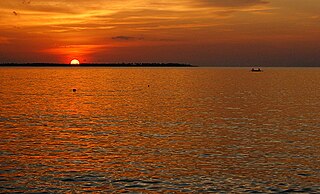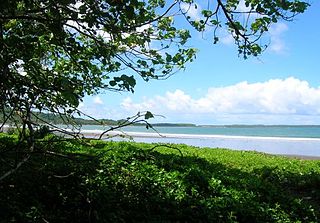
Leyte, officially the Province of Leyte, is a province in the Philippines located in the Eastern Visayas region occupying the northern three-quarters of Leyte Island. Its capital is the city of Tacloban, administered independently from the province, as well as the regional center of Eastern Visayas. Leyte is thus north of Southern Leyte, south of Biliran, and west of Samar Island. To the west across the Camotes Sea is the province of Cebu.

Biliran, officially the Province of Biliran, is an island province in the Philippines located in the Eastern Visayas region. Biliran is one of the country's smallest and newest provinces. Formerly a sub-province of Leyte, it became an independent province in 1992.

Eastern Samar, officially the Province of Eastern Samar, is a province in the Philippines located in the Eastern Visayas region. Its capital is the city of Borongan, which is the most populous. Eastern Samar occupies the eastern portion of the island of Samar. Bordering the province to the north is the province of Northern Samar and to the west is Samar province. To the east lies the Philippine Sea, part of the vast Pacific Ocean, while to the south lies Leyte Gulf.

Samar, officially the Province of Samar, or also known named as Western Samar, is a province in the Philippines located in the Eastern Visayas region. Its capital is the city of Catbalogan while Calbayog is the most populous city in the province. It is bordered by Northern Samar, Eastern Samar, Leyte and Leyte Gulf, and includes several islands in the Samar Sea. Samar is connected to the island of Leyte via the San Juanico Bridge.

Catarman, officially the Municipality of Catarman, is a 1st class municipality and capital of the province of Northern Samar, Philippines. According to the 2020 census, it has a population of 97,879 people. It is the commercial, educational, financial, and political center of the province. It is the most populous municipality in Eastern Visayas.

Matuguinao, officially the Municipality of Matuguinao, is a 5th class municipality in the province of Samar, Philippines. According to the 2020 census, it has a population of 7,364 people, making it the least populated municipality in the province.

Bobon, officially the Municipality of Bobon, is a 4th class municipality in the province of Northern Samar, Philippines. According to the 2020 census, it has a population of 25,964 people.

Capul, officially the Municipality of Capul, is a 5th class island municipality in the province of Northern Samar, Philippines. According to the 2020 census, it has a population of 12,323 people.

Catubig, officially the Municipality of Catubig, is a 3rd class municipality in the province of Northern Samar, Philippines. According to the 2020 census, it has a population of 32,174 people.

Gamay, officially the Municipality of Gamay, is a 4th class municipality in the province of Northern Samar, Philippines. According to the 2020 census, it has a population of 23,367 people.

Laoang, officially the Municipality of Laoang, is a 2nd class municipality in the province of Northern Samar, Philippines. According to the 2020 census, it has a population of 61,607 people.

Lavezares, officially the Municipality of Lavezares, is a 4th class municipality in the province of Northern Samar, Philippines. According to the 2020 census, it has a population of 29,390 people.

Lope de Vega, officially the Municipality of Lope de Vega, is a 4th class municipality in the province of Northern Samar, Philippines. According to the 2020 census, it has a population of 14,690 people.

Palapag, officially the Municipality of Palapag, is a 3rd class municipality in the province of Northern Samar, Philippines. According to the 2020 census, it has a population of 34,034 people.

Pambujan, officially the Municipality of Pambujan, is a 4th class municipality in the province of Northern Samar, Philippines. According to the 2020 census, it has a population of 35,532 people.

San Vicente, officially the Municipality of San Vicente, is a 6th class municipality in the province of Northern Samar, Philippines.

Borongan, officially the City of Borongan, is a 1st class component city and capital of the province of Eastern Samar, Philippines. According to the 2020 census, it has a population of 71,961 people.

General MacArthur, officially the Municipality of General MacArthur, is a 5th class municipality in the province of Eastern Samar, Philippines. According to the 2020 census, it has a population of 14,411 people.

Eastern Visayas is an administrative region in the Philippines, designated as Region VIII. It consists of three main islands: Samar, Leyte, and Biliran. The region has six provinces: Biliran, Leyte, Northern Samar, Samar, Eastern Samar, Southern Leyte, one independent city, Ormoc, and one highly urbanized city, Tacloban. The highly urbanized city of Tacloban is the sole regional center. These provinces and cities occupy the easternmost islands of the Visayas group of islands, hence the region's name. Some historians believe that the oldest ancient kingdom in the Philippines is found in this region, the Lakanate of Lawan, which plays a significant role in the Polynesian and Austronesian intermigration.

Samar was a province in the Philippines which is coterminous with the island of Samar and its outlying islands. It existed from the Spanish colonization era until its division into three provinces—Eastern Samar, Northern Samar, and Western Samar —in 1965.



































